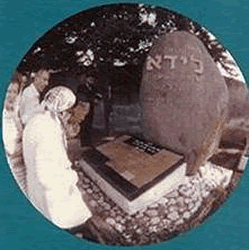|
Inhabitants of the Lida Ghetto Organize a Struggle against the Nazi Opressor
|
| Inhabitants of the Lida Ghetto Organize One week after the beginning of the war, on June 22, 1941, Lida was captured. Three months later, after the Jews had suffered various draconian measures, they were ordered to enter the ghetto, since the city had been destroyed by the bombing. Three areas were established: We were forced to engage in various types of work and in many instances we were degraded and beaten. One morning, at the beginning of February 1942, we were driven from our homes by the Germans and their Lithuanian accomplices, with shots and shouts, to the square in the center of town . After the Selection, several hundred Jews, refugees from Vilna, were executed. On the 8th of May, the scene was repeated. We were driven with blows and shots, to pits, which had been dug beforehand. We were about 10,000 Jews. The Germans conducted a Selection. The sick, the old and all those who were unble to work were murdered. Out of the 10,000, only 1,500 young people remained. The arae commander, Hanveg, knew my father, who was a manager of a metals factory. He took us out of the valley of killing. Broken and depressed, we returned to the central ghetto and assembled in the homes of the murdered Jews. After a few days, we were joined by about 1,500 young people who came from the neighboring ghettos, most of them without families. The Feldman brothers, Baruch Levin, Zerach Arliuk, Yaakov Druck and his family from the town of Varanova, my cousin David Boirski with his sister and her husband Moshe, all came. After we recovered somewhat, we organized secretly and speculated how to act against the Nazis. David, armed with a rifle, left to fight in the forest. At one stage, he returned in order to try to save his sister and his brother-in-law and to have them join the group in the forest. The plan did not succeed.. They were murdered in the last transport to Majdanek. The house in which we lived, at 15 Chalodna Street, became a meeting place. Baruch Levin suggested that we should somehow obtain weapons and resist being led to the death pits time after time. He would go up to the attic, armed with an axe and make speeches in favor of resistance and fighting. Those present supported him, and understood that it was necessary to obtain weapons, by any means. Ignatz was the first who obtained two pistols and we found a number of ways to reach the goal which we had set for ourselves: 1. We found weapons, unusable as a result of explosions or fires. We dismantled them, straightened the barrels and made them servicable. 2. It came to our attention that near the town of Kesht there was a dump of Russian equipment. Baruch Levin and his friend Zeev Karopsky, requested permission from Honveg, the commander of the area, to go there in order to collect tins and other metal parts which were needed for our work. We received his permission, traveled there and found what we needed. We collected, among other things, rifles and machine guns, repaired them with great effort, and then they were then ready for use. 3. Some of the weapons we bought in exchange for gold from Polish friends, in spite of the danger involved. In many cases, these same "friends" were revealed later as informers. A number of our members were caught and murdered. Aside from our member Zerach, Zipalevich also had military experience. (He had served as an officer in the Company of Marshal Pilsudski.) Zipalevich devoted himself to assisting us, and participated in all our meetings.. The house on Chalodna Street became the headquarters and all the decisions were made there. Our first thought was to organize for a struggle within the ghetto, and that on the day when the Germans would want to lead us to the final liquidation, we would fight against them and attempt to reach the forest. The leaders of the ghetto and most of the inhabitants were opposed to this. They believed the Nazi propaganda, which claimed that whoever worked would not be harmed. We did not want to act against their will, so we decided to try to contact the Russian partisans and to join them. The connection was made, thanks to Eliyahu Vilenski and Baruch Levin's brother-in-law, who arrived from the Lepitzin Forests in search of a doctor.They met Dr. Miasnik, a well-known surgeon. Baruch Levin, Zeev Karposki, the Manski brothers and another group of about 20 men, joined them. Armed with weapons and machine-guns, they joined Vilenski's group, which included, among others, Sarah Arliuk, Avrasha Arliuk (Loit), Chaim Kaminski (Kalminovich) and tens of others. Later on they were joined by other groups. The youth Lionek, a lone refugee from Vilna, whose entire family had been murdered, was the liaison between the ghetto and the forest. The Poles informed on him, he was arrested by the Nazis and interrogated. Lionek did not divulge a single detail about our organization in the ghetto and died bravely, under great torture. At the beginning of April 1943, on the eve of Pesach, my family and I, in a group of about 50 people, armed with weapons, left for the Bielski camp. We were received joyfully, especially by Tuvia, the commander. |
|
|
